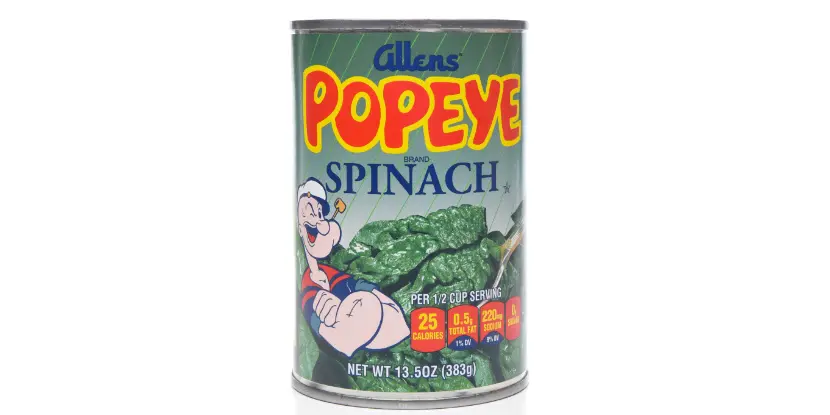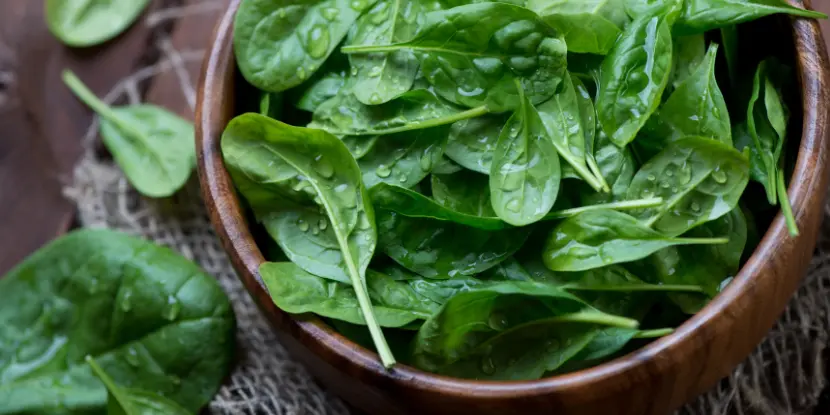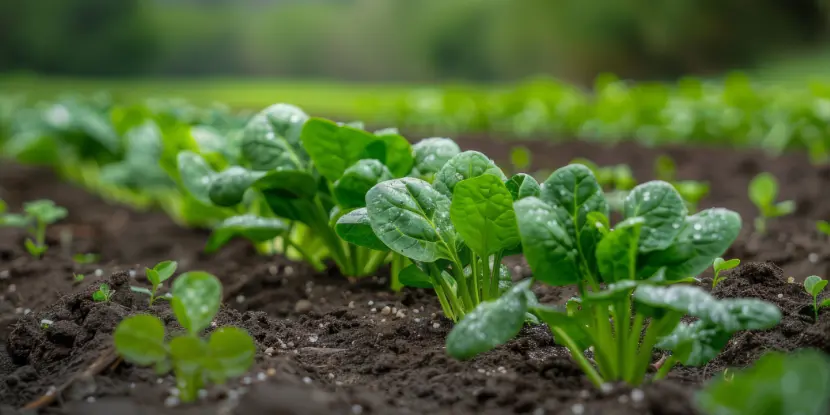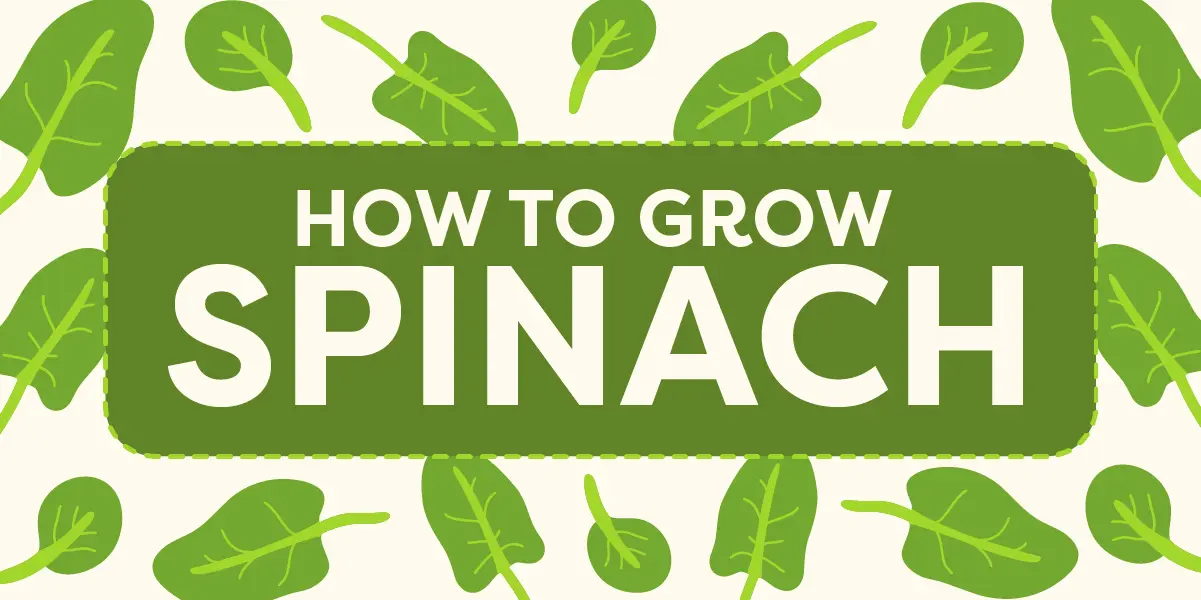Spinach may not give you forearms like Popeye — sorry, that’s a cartoon myth — but it’s a nutritional powerhouse and a top-ten vegetable for your garden. It’s loaded with vitamins and minerals that support good health.
Vitamins
- Vitamin A — Supports vision and immune function.
- Vitamin C — Boosts immune health and acts as an antioxidant.
- Vitamin K — Essential for blood clotting and bone health.

Want forearms like Popeye? Eat your spinach!
Minerals
- Iron — Crucial for red blood cell production.
- Calcium — Important for bone health.
- Magnesium — Helps with muscle and nerve function.
Antioxidants
- Lutein and Zeaxanthin — Promote eye health.
- Quercetin — Has anti-inflammatory properties.
Plus, spinach is a versatile leafy green that can be prepared in so many tasty ways—raw in salads, boiled, steamed, baked, and fried. Have you ever tried frying lettuce? Yeah.
Origins of Spinach
Spinach is native to Central and Western Asia. It hails from Persia (modern-day Iran), where it was cultivated over 2,000 years ago. The Moors introduced spinach to Spain in the 11th century, and it quickly spread throughout Europe.
Historical records show that spinach was a favorite among royalty and commoners due to its rapid growth and nutritional benefits. Today, it’s a staple in kitchens and cuisines worldwide.

Baby spinach leaves in a wooden salad bowl. Dressing, please!
Popular Varieties
Savoy Spinach
- Crinkly, dark green leaves
- Robust flavor
- Ideal for salads and cooking
Semi-Savoy Spinach
- A hybrid between savoy and flat-leaf
- Offers a balance of texture and ease of cleaning
- Suitable for salads and cooking
Flat-leaf Spinach
- Often referred to as “baby spinach”
- The most common type sold in American supermarkets
- Smooth, broad leaves
- Easy to clean and prepare
- Often used in canned and frozen products
Ideal Growing Conditions
Temperature
Spinach is a cool-season crop that thrives in mild temperatures. It germinates best at temperatures between 50°F and 68°F (10°C to 20°C). High temperatures can cause spinach to bolt or go to seed prematurely.

Young spinach plants in growing in a field.
Optimal range
- Daytime temperatures of 60°F to 70°F (15°C to 21°C).
- Nighttime temperatures around 50°F (10°C).
Avoid extremes
- Temperatures above 75°F (24°C) can lead to bolting.
- Frost can damage young seedlings.
Light
Spinach grows best in partial shade, but it can tolerate full sun. In hot climates, providing some afternoon shade can help prevent bolting.
Soil
Spinach requires well-drained, fertile soil.
- Loamy soil works best.
- Ensure good drainage to prevent root rot.
- The ideal soil pH is between 6.0 and 7.0.
- Use a soil test kit to check your pH levels before planting.
- Enrich soil with organic matter like compost.
- Avoid soil with high nitrogen levels to prevent excessive leaf growth and poor flavor.
Planting Spinach from Seed
Spinach is typically grown from seed rather than transplanting because of its delicate roots. Follow these steps for successful germination:
- Prepare your garden bed — Clear any debris and remove weeds that may compete for nutrients. Amend the soil with organic matter, such as compost or aged manure, to improve drainage and add nutrients.
- Sow seeds directly into the ground — Spinach can be planted in rows or broadcast (scattered) over a designated area. Sow seeds 1/2 inch deep and space them one inch apart. Cover them with a thin layer of soil and gently pat down to ensure good seed-to-soil contact.
- Water thoroughly — Keep the soil moist but not waterlogged until germination occurs (usually within 7-14 days). After germination, reduce watering to prevent root rot.
- Thin seedlings — Once seedlings appear, thin them to about three inches apart. This allows adequate space for mature plants.

Freshly harvested spinach plants.
When to Plant in Southern California
Spinach can be planted year-round in cooler coastal areas. Inland valleys may have more success growing spinach during the fall and winter months when temperatures are milder.
Caring for Spinach Plants
Watering
- Spinach has shallow roots. Keep the soil consistently moist but not soggy.
- Use drip irrigation or a soaker hose. Water early in the morning to reduce evaporation; avoid wetting leaves.
- Water 1–2 times per week, depending on weather conditions. Increase frequency during dry spells.
Fertilizing Spinach
- Use a balanced, all-purpose fertilizer. Organic options like compost or fish emulsion work well.
- Apply fertilizer before planting. Side-dress plants with additional fertilizer during the growing season.
- Excessive nitrogen can lead to poor flavor. Follow package instructions for application rates.
Pests & Diseases
Common Pests
- Aphids, leaf miners, and slugs.
- Use natural predators or insecticidal soap to control pests.
Diseases
- Downy mildew, leaf spot, and root rot.
- Ensure proper spacing and air circulation to prevent fungal infections.
Preventive Measures
- Rotate crops annually.
- Remove affected leaves promptly.

Breakfast burrito, anyone? It’s so much better with spinach.
When to Harvest
Harvesting spinach at the right time ensures the best flavor and texture.
- Baby spinach is ready for harvest within 20–30 days.
- Harvest leaves when they’re large enough to eat.
- Cut outer leaves first, allowing inner leaves to continue growing.
- Use scissors or a sharp knife.
- Use within a week for optimal freshness.
Growing Spinach In Containers
Spinach is one of the easiest vegetables to grow in containers, making it a good choice for urban gardens.
- Use a container at least 6–8 inches deep.
- Fill with quality potting mix and ensure good drainage.
- Plant seeds about one inch apart, covering with a thin layer of soil.
- Place in an area that receives partial shade. Sun exposure can cause spinach to bolt quickly.
- Water as needed to keep the soil moist but not soggy.
Hydroponic Gardening Indoors
Spinach can also be grown hydroponically, which involves cultivating plants in nutrient-rich water instead of soil.
- Use a hydroponic system designed for leafy greens.
- Follow manufacturer instructions for setup and nutrient solutions.
- Keep the growing area well-lit with LED or fluorescent lights. Spinach needs 12–16 hours of light per day.
Companion Planting
Growing spinach alongside other plants can mutually benefit both crops.
- Plant beans, peas, and other legumes near spinach to add nitrogen to the soil.
- Avoid planting with members of the cabbage family, which may compete for nutrients.
- Plant near herbs like thyme and rosemary to repel pests.

Spinach can be blended into smoothies for an extra-nutritious drink.
Tasty Ways to Enjoy Spinach
It’s also low in calories and high in nutrient value. Here are easy ways to incorporate it into your diet:
- Add raw baby spinach leaves to salads for extra crunch and nutrition.
- Toss cooked spinach into pasta dishes, soups, and stir-fries.
- Blend spinach into smoothies for a boost of vitamins and minerals.
- Incorporate chopped spinach into omelets or frittatas for a satisfying breakfast.
- Use it as a topping on pizza or in sandwiches.
FAQs: Growing Spinach
Q: How often should I water spinach?
Water consistently to keep the soil moist but not soggy, typically 1–2 times per week, depending on weather conditions.
Q: Can I grow spinach indoors year-round?
Spinach can be grown indoors throughout the year with adequate light and proper care.
Q: What should I do if my spinach bolts?
Remove bolted plants promptly to prevent them from affecting neighboring plants. Consider planting a new crop in a cooler part of the season.
Q: What is the best way to prevent pests on my spinach plants?
Use natural predators like ladybugs or beneficial nematodes, and apply insecticidal soap if needed. Regularly inspect plants for signs of infestations and remove affected leaves promptly.
Q: How long does it take for spinach seeds to germinate?
Depending on temperature and moisture levels, spinach seeds typically germinate within 7 to 14 days. To encourage successful germination, ensure the soil remains consistently moist.
Q: Can I use spinach plants that have bolted?
Spinach plants that have bolted often develop a bitter flavor. While leaves can be used in cooked dishes, it’s generally best to remove bolted plants to make room for new ones.
Q: What should I do if my spinach leaves have yellow spots?
Yellow spots could indicate a fungal infection like downy mildew. To minimize spread, ensure adequate airflow by properly spacing plants, avoiding overhead watering, and removing affected leaves.
Q: How can I store harvested spinach to maintain freshness?
Wash and thoroughly dry the leaves. Place them in a container or plastic bag with a paper towel to absorb moisture, and store them in the refrigerator, where they will keep fresh for up to a week.

